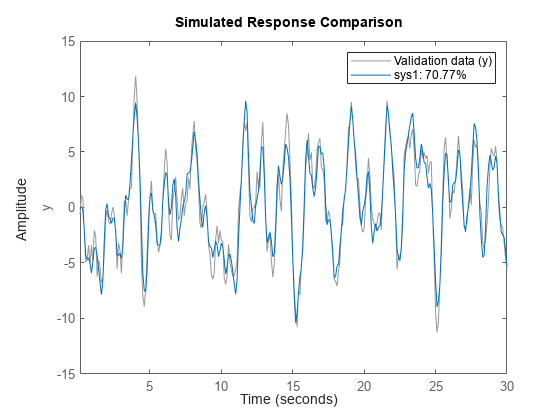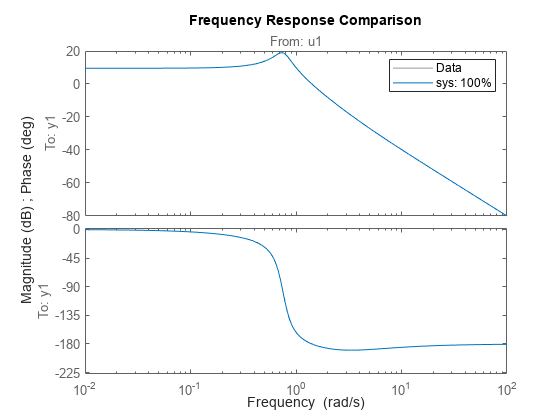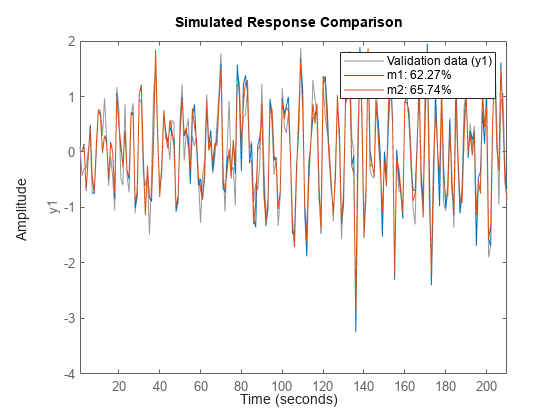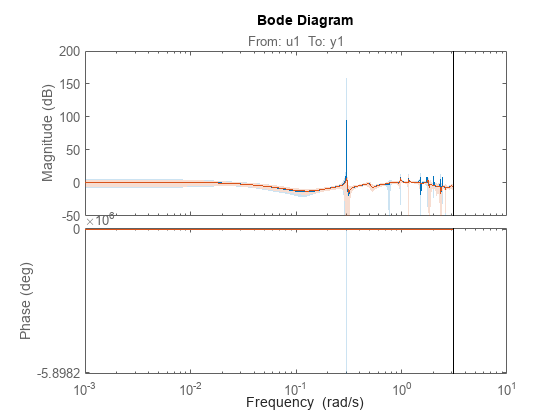oe
Estimate output-error polynomial model using time-domain or frequency-domain data
Syntax
Description
Output-error (OE) models are a special configuration of polynomial models, having
only two active polynomials—B and F. OE models represent
conventional transfer functions that relate measured inputs to outputs while also including
white noise as an additive output disturbance. You can estimate OE models using time- and
frequency-domain data. The tfest command offers the same functionality as
oe. For tfest, you specify the model orders using
number of poles and zeros rather than polynomial degrees. For continuous-time estimation,
tfest provides faster and more accurate results, and is
recommended.
Estimate OE Model
sys = oe(tt,[nb
nf nk])sys using the data contained in the variables
of timetable tt. The software uses the first Nu
variables as inputs and the next Ny variables as outputs, where
Nu and Ny are determined from the dimensions of
the specified polynomial orders.
sys is represented by the equation
Here, y(t) is the output, u(t) is the input, and e(t) is the error.
The orders [nb nf nk] define the number of parameters in each
component of the estimated polynomial.
To select specific input and output channels from tt, use
name-value syntax to set 'InputName' and
'OutputName' to the corresponding timetable variable names.
sys = oe(u,y,[nb nf nk])u,y. The software assumes that the data sample
time is 1 second. To change the sample time, set Ts using name-value
syntax.
sys = oe(data,[nb
nf nk])data.
sys = oe(___,Name,Value)
Configure Initial Parameters
Specify Additional Estimation Options
Return Estimated Initial Conditions
[
returns the estimated initial conditions as an sys,ic] = oe(___)initialCondition
object. Use this syntax if you plan to simulate or predict the model response using the
same estimation input data and then compare the response with the same estimation output
data. Incorporating the initial conditions yields a better match during the first part of
the simulation.
Examples
Estimate an OE polynomial from time-domain data using two methods to specify input delay.
Load the estimation data.
load sdata1 tt1
Set the orders of the B and F polynomials nb and nf. Set the input delay nk to one sample. Compute the model sys.
nb = 2; nf = 2; nk = 1; sys = oe(tt1,[nb nf nk]);
Compare the simulated model response with the measured output.
compare(tt1,sys)

The plot shows that the fit percentage between the simulated model and the estimation data is greater than 70%.
Instead of using nk, you can also use the name-value pair argument 'InputDelay' to specify the one-sample delay.
nk = 0;
sys1 = oe(tt1,[nb nf nk],'InputDelay',1);
figure
compare(tt1,sys1)
The results are identical.
You can view more information about the estimation by exploring the idpoly property sys.Report.
sys.Report
ans =
Status: 'Estimated using OE'
Method: 'OE'
InitialCondition: 'zero'
Fit: [1×1 struct]
Parameters: [1×1 struct]
OptionsUsed: [1×1 idoptions.polyest]
RandState: [1×1 struct]
DataUsed: [1×1 struct]
Termination: [1×1 struct]
For example, find out more information about the termination conditions.
sys.Report.Termination
ans = struct with fields:
WhyStop: 'Near (local) minimum, (norm(g) < tol).'
Iterations: 3
FirstOrderOptimality: 0.0708
FcnCount: 7
UpdateNorm: 1.4809e-05
LastImprovement: 5.1744e-06
The report includes information on the number of iterations and the reason the estimation stopped iterating.
Load the estimation data.
load oe_data1 data;
The idfrd object data contains the continuous-time frequency response for the following model:
Estimate the model.
nb = 2; nf = 3; sys = oe(data,[nb nf]);
Evaluate the goodness of fit.
compare(data,sys);

Estimate a high-order OE model from data collected by simulating a high-order system. Determine the regularization constants by trial and error and use the values for model estimation.
Load the data.
load regularizationExampleData.mat m0simdata
Estimate an unregularized OE model of order 30.
m1 = oe(m0simdata,[30 30 1]);
Obtain a regularized OE model by determining the Lambda value using trial and error.
opt = oeOptions; opt.Regularization.Lambda = 1; m2 = oe(m0simdata,[30 30 1],opt);
Compare the model outputs with the estimation data.
opt = compareOptions('InitialCondition','z'); compare(m0simdata,m1,m2,opt);

The regularized model m2 produces a better fit than the unregularized model m1.
Compare the variance in the model responses.
bp = bodeplot(m1,m2);
bp.PhaseMatchingEnabled = "on";
bp.Characteristics.ConfidenceRegion.NumberOfStandardDeviations = 3;
showConfidence(bp);
The regularized model m2 has a reduced variance compared to the unregularized model m1.
Load the estimation data data and sample time Ts.
load oe_data2.mat data Ts
An iddata object data contains the discrete-time frequency response for the following model:
View the estimation sample time Ts that you loaded.
Ts
Ts = 1.0000e-03
This value matches the property data.Ts.
data.Ts
ans = 1.0000e-03
You can estimate a continuous model from data by limiting the input and output frequency bands to the Nyquist frequency. To do so, specify the estimation prefilter option 'WeightingFilter' to define a passband from 0 to 0.5*pi/Ts rad/s. The software ignores any response values with frequencies outside of that passband.
opt = oeOptions('WeightingFilter',[0 0.5*pi/Ts]); Set the Ts property to 0 to treat data as continuous-time data.
data.Ts = 0;
Estimate the continuous model.
nb = 1; nf = 3; sys = oe(data,[nb nf],opt);
Load the data, which consists of input and output data in matrix form and the sample time.
load sdata1i umat1i ymat1i Ts1i
Estimate an OE polynomial model sys and return the initial conditions in ic.
nb = 2;
nf = 2;
nk = 1;
[sys,ic] = oe(umat1i,ymat1i,[nb,nf,nk],'Ts',Ts1i);
icic =
initialCondition with properties:
A: [2×2 double]
X0: [2×1 double]
C: [0.9428 0.4824]
Ts: 0.1000
ic is an initialCondition object that encapsulates the free response of sys, in state-space form, to the initial state vector in X0. You can incorporate ic when you simulate sys with the umat1i input signal and compare the response with the ymat1i output signal.
Input Arguments
Estimation data, specified as a timetable that uses a regularly spaced time
vector. tt contains variables representing input and output
channels. For multiexperiment data, tt is a cell array of
timetables of length Ne, where Ne is the
number of experiments.
The software determines the number of input and output channels to use for estimation from the
dimensions of the specified polynomial orders. The input/output channel selection
depends on whether the 'InputName' and
'OutputName' name-value arguments are specified.
If
'InputName'and'OutputName'are not specified, then the software uses the first Nu variables ofttas inputs and the next Ny variables ofttas outputs.If
'InputName'and'OutputName'are specified, then the software uses the specified variables. The number of specified input and output names must be consistent with Nu and Ny.For functions that can estimate a time series model, where there are no inputs,
'InputName'does not need to be specified.
For more information about working with estimation data types, see Data Domains and Data Types in System Identification Toolbox.
Estimation data, specified for SISO systems as a comma-separated pair of Ns-by-1 real-valued matrices that contain uniformly sampled input and output time-domain signal values. Here, Ns is the number of samples.
For MIMO systems, specify u,y as an
input/output matrix pair with the following dimensions:
u— Ns-by-Nu, where Nu is the number of inputs.y— Ns-by-Ny, where Ny is the number of outputs.
For multiexperiment data, specify u,y as a
pair of 1-by-Ne cell arrays, where
Ne is the number of experiments. The
sample times of all the experiments must match.
For time series data, which contains only outputs and no inputs, specify
[],y.
Limitations
For more information about working with estimation data types, see Data Domains and Data Types in System Identification Toolbox.
Estimation data, specified as an iddata object, an frd object, or an idfrd object.
For time-domain estimation, data must be an iddata object containing the input and output signal values.
For frequency-domain estimation, data can be one of the following:
Time-domain estimation data must be uniformly sampled. By default, the software sets the sample time of the model to the sample time of the estimation data.
For multiexperiment data, the sample times and intersample behavior of all the experiments must match.
You can compute discrete-time models from time-domain data or discrete-time
frequency-domain data. Use tfest to compute continuous-time
models.
OE model orders, specified as a 1-by-3 vector or a vector of integer matrices.
For a system represented by
where y(t) is the output,
u(t) is the input, and
e(t) is the error, the elements of [nb
nf nk] are as follows:
nb— Order of the B(q) polynomial + 1, which is equivalent to the length of the B(q) polynomial.nbis an Ny-by-Nu matrix. Ny is the number of outputs and Nu is the number of inputs.nf— Order of the F polynomial.nfis an Ny-by-Nu matrix.nk— Input delay, expressed as the number of samples.nkis an Ny-by-Nu matrix. The delay appears as leading zeros of the B polynomial.
For estimation using continuous-time frequency-domain data, specify only
[nb nf] and omit nk. For an example, see Estimate Continuous-Time OE Model Using Frequency Response.
Linear system that configures the initial parameterization of
sys, specified as an idpoly model, another
linear model, or a structure. You obtain init_sys either by
performing an estimation using measured data or by direct construction.
If init_sys is an idpoly model of the OE
structure, oe uses the parameter values of
init_sys as the initial guess for estimating
sys. The sample time of init_sys must match
the sample time of the data.
Use the Structure property of init_sys to
configure initial guesses and constraints for B(q)
and F(q). For example:
To specify an initial guess for the F(q) term of
init_sys, setinit_sys.Structure.F.Valueas the initial guess.To specify constraints for the B(q) term of
init_sys:Set
init_sys.Structure.B.Minimumto the minimum B(q) coefficient values.Set
init_sys.Structure.B.Maximumto the maximum B(q) coefficient values.Set
init_sys.Structure.B.Freeto indicate which B(q) coefficients are free for estimation.
If init_sys is not a polynomial model of the OE structure, the
software first converts init_sys to an OE structure model.
oe uses the parameters of the resulting model as the initial
guess for estimating
sys.
If you do not specify opt and init_sys was
obtained by estimation, then the software uses estimation options from
init_sys.Report.OptionsUsed.
Estimation options, specified as an oeOptions option set. Options specified by opt
include:
Estimation objective
Handling of initial conditions
Numerical search method and the associated options
For examples of specifying estimation options, see Estimate Continuous Model Using Band-Limited Discrete-Time Frequency-Domain Data.
Name-Value Arguments
Specify optional pairs of arguments as
Name1=Value1,...,NameN=ValueN, where Name is
the argument name and Value is the corresponding value.
Name-value arguments must appear after other arguments, but the order of the
pairs does not matter.
Before R2021a, use commas to separate each name and value, and enclose
Name in quotes.
Example: 'InputDelay',1
Input channel names, specified as a string, character vector, string array, or cell array of character vectors.
If you are using a timetable for the data source, the names in
InputName must be a subset of the timetable variables.
Example: sys = oe(tt,__,'InputName',["u1" "u2"]) selects
the variables u1 and u2 as the input channels from
the timetable tt to use for the estimation.
Output channel names, specified as a string, character vector, string array, or cell array of character vectors.
If you are using a timetable for the data source, the names in
OutputName must be a subset of the timetable variables.
Example: sys = oe(tt,__,'OutputName',["y1" "y3"]) selects
the variables y1 and y3 as the output channels
from the timetable tt to use for the estimation.
Sample time, specified as the comma-separated pair consisting of 'Ts' and
the sample time in the units specified by TimeUnit. When you use
matrix-based data (u,y), you must specify
Ts if you require a sample time other than the assumed sample
time of 1 second.
To obtain the data sample time for a timetable tt, use the timetable property tt.Properties.Timestep.
Example: oe(umat1,ymat1,___,'Ts',0.08) computes a model with sample
time of 0.08 seconds.
Input delays for each input channel, specified as the comma-separated pair
consisting of 'InputDelay' and a numeric vector.
For continuous-time models, specify
'InputDelay'in the time units stored in theTimeUnitproperty.For discrete-time models, specify
'InputDelay'in integer multiples of the sample timeTs. For example, setting'InputDelay'to3specifies a delay of three sampling periods.
For a system with Nu inputs, set
InputDelay to an
Nu-by-1 vector. Each entry of this vector is
a numerical value that represents the input delay for the corresponding input
channel.
To apply the same delay to all channels, specify 'InputDelay'
as a scalar.
For an example, see Estimate OE Polynomial Model.
Transport delays for each input-output pair, specified as the comma-separated pair
consisting of 'IODelay' and a numeric array.
For continuous-time models, specify
'IODelay'in the time units stored in theTimeUnitproperty.For discrete-time models, specify
'IODelay'in integer multiples of the sample timeTs. For example, setting'IODelay'to4specifies a transport delay of four sampling periods.
For a system with Nu inputs and
Ny outputs, set
'IODelay' to an
Ny-by-Nu
matrix. Each entry is an integer value representing the transport delay for the
corresponding input-output pair.
To apply the same delay to all channels, specify 'IODelay' as
a scalar.
You can specify 'IODelay' as an alternative to the
nk value. Doing so simplifies the model structure by reducing the
number of leading zeros in the B polynomial. In particular, you can
represent max(nk-1,0) leading zeros as input-output delays using
'IODelay' instead.
Output Arguments
OE polynomial model that fits the estimation data, returned as an idpoly model object. This model is created using the specified model
orders, delays, and estimation options. The sample time of sys
matches the sample time of the estimation data. Therefore, sys is
always a discrete-time model when estimated from time-domain data. For continuous-time
model identification using time-domain data, use tfest.
The Report property of the model stores information about the
estimation results and options used. Report has the following
fields.
| Report Field | Description |
|---|---|
Status | Summary of the model status, which indicates whether the model was created by construction or obtained by estimation |
Method | Estimation command used |
InitialCondition | Handling of initial conditions during model estimation, returned as one of the following values:
This field is especially useful to view
how the initial conditions were handled when the |
Fit | Quantitative assessment of the estimation, returned as a structure. See Loss Function and Model Quality Metrics for more information on these quality metrics. The structure has these fields.
|
Parameters | Estimated values of model parameters |
OptionsUsed | Option set used for estimation. If no custom options were
configured, this is a set of default options. See |
RandState | State of the random number stream at the start of estimation. Empty,
|
DataUsed | Attributes of the data used for estimation, returned as a structure with the following fields.
|
Termination | Termination conditions for the iterative search used for prediction error minimization, returned as a structure with these fields.
For estimation methods that do not require numerical search
optimization, the |
For more information on using Report, see Estimation Report.
Estimated initial conditions, returned as an initialCondition object or an object array of
initialCondition values.
For a single-experiment data set,
icrepresents, in state-space form, the free response of the transfer function model (A and C matrices) to the estimated initial states (x0).For a multiple-experiment data set with Ne experiments,
icis an object array of length Ne that contains one set ofinitialConditionvalues for each experiment.
If oe returns ic values of
0 and the you know that you have non-zero initial conditions, set
the 'InitialCondition' option in oeOptions to 'estimate' and pass the updated option set
to oe. For
example:
opt = oeOptions('InitialCondition','estimate') [sys,ic] = oe(data,np,nz,opt)
'auto' setting of 'InitialCondition' uses
the 'zero' method when the initial conditions have a negligible
effect on the overall estimation-error minimization process. Specifying
'estimate' ensures that the software estimates values for
ic.For more information, see initialCondition. For an example of using this argument, see Obtain Initial Conditions.
More About
The general output-error model structure is:
The orders of the output-error model are:
If data is continuous-time frequency-domain data,
oe estimates a continuous-time model with the following transfer
function:
The orders of the numerator and denominator are nb and
nf, similar to the discrete-time case. However, the sample delay
nk does not exist in the continuous case, and you should not specify
nk when you command the estimation. Instead, express any system delay
using the name-value pair argument 'IODelay' along with the system delay
in the time units that are stored in the property TimeUnit. For example,
suppose that your continuous system has a delay of iod seconds. Use
model = oe(data,[nb nf],'IODelay',iod).
Version History
Introduced before R2006aMost estimation, validation, analysis, and utility functions now accept time-domain
input/output data in the form of a single timetable that contains both input and output data
or a pair of matrices that contain the input and output data separately. These functions
continue to accept iddata objects as a data source as well, for
both time-domain and frequency-domain data.
Specification of lsqnonlin- related advanced options are deprecated,
including the option to invoke parallel processing when estimating using the
lsqnonlin search method, or solver, in Optimization Toolbox™.
MATLAB Command
You clicked a link that corresponds to this MATLAB command:
Run the command by entering it in the MATLAB Command Window. Web browsers do not support MATLAB commands.
Seleccione un país/idioma
Seleccione un país/idioma para obtener contenido traducido, si está disponible, y ver eventos y ofertas de productos y servicios locales. Según su ubicación geográfica, recomendamos que seleccione: .
También puede seleccionar uno de estos países/idiomas:
Cómo obtener el mejor rendimiento
Seleccione China (en idioma chino o inglés) para obtener el mejor rendimiento. Los sitios web de otros países no están optimizados para ser accedidos desde su ubicación geográfica.
América
- América Latina (Español)
- Canada (English)
- United States (English)
Europa
- Belgium (English)
- Denmark (English)
- Deutschland (Deutsch)
- España (Español)
- Finland (English)
- France (Français)
- Ireland (English)
- Italia (Italiano)
- Luxembourg (English)
- Netherlands (English)
- Norway (English)
- Österreich (Deutsch)
- Portugal (English)
- Sweden (English)
- Switzerland
- United Kingdom (English)